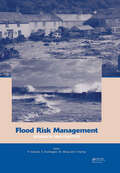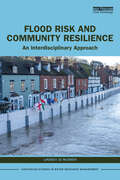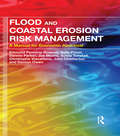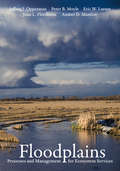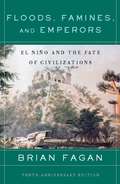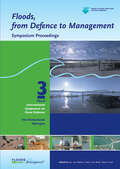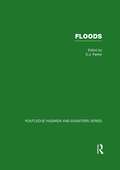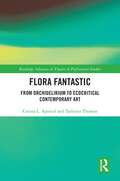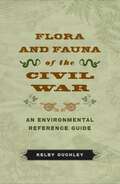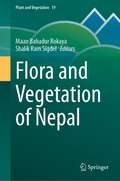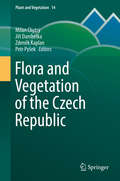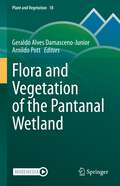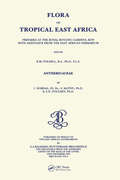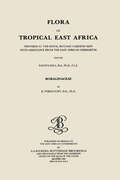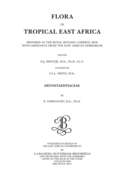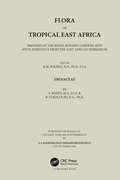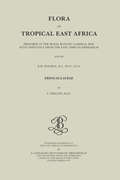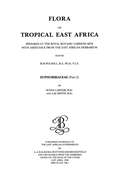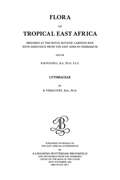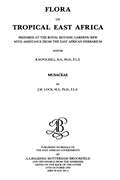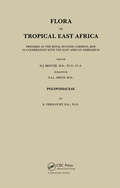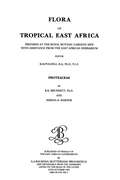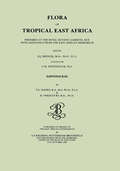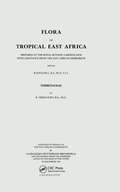- Table View
- List View
Flood Risk Management: Extended Abstracts Volume (332 pages) + full paper CD-ROM (1772 pages)
by Paul Samuels Stephen Huntington William Allsop Jackie HarropFloods cause distress and damage wherever and whenever they happen. Flooding from rivers, estuaries and the sea threatens many millions of people worldwide and economic and insurance losses from flooding have increased significantly since 1990. Based on the work of leading researchers, this book provides an overview of advances in this important subject. It covers all aspects of flood risk including the causes of floods; their impacts on people, property and the environment; and portfolios of risk management measurement. Additional topics include climate change, estimation of extremes, flash floods, flood forecasting and warning, inundation modeling, systems analysis, uncertainty, international programs, and flood defense infrastructure and assets. The book also examines environmental, human, and social impacts; vulnerability and resilience; risk sharing; and civil contingency planning and emergency management.
Flood Risk and Community Resilience: An Interdisciplinary Approach (Earthscan Studies in Water Resource Management)
by Lindsey Jo McEwenThis book details the impact of flooding on our environment, and the ways in which communities, and those that work with them, can act to manage the associated risks.Flooding is an increasingly significant environmental hazard which inflicts major costs to the economies and livelihoods of developed countries. This book explores how local communities can identify, manage, and adapt to the ever-increasing damage flooding causes. Focusing on the future role of local communities, the benefits and challenges of their involvement, and the potential areas of transformation, this book provides insights into the efficacy of interdisciplinary and transdisciplinary working. Alongside research into similar environmental hazards, this book also draws upon the author’s own knowledge of flood risk management in distinctive non-contiguous interdisciplinary settings. The chapters draw together a different and distinctive set of interdisciplinary themes in flood risk management and social resilience. In doing so, it strives to communicate the different ways of thinking that can usefully contribute to flood risk management.This book would be ideal for those researching flood risk management, alongside scholars and non-scholars alike who are interested in finding ways of adapting to environmental hazards working with local communities.
Flood and Coastal Erosion Risk Management: A Manual for Economic Appraisal
by Edmund Penning-Rowsell Sally Priest Dennis Parker Joe Morris Sylvia Tunstall Christophe Viavattene John Chatterton Damon OwenA new ‘Multi-Coloured Manual' This book is a successor to and replacement for the highly respected manual and handbook on the benefits of flood and coastal risk management, produced by the Flood Hazard Research Centre at Middlesex University, UK, with support from Defra and the Environment Agency. It builds upon a previous book known as the "multi-coloured manual" (2005), which itself was a synthesis of the blue (1977), red (1987) and yellow manuals (1992). As such it expands and updates this work, to provide a manual of assessment techniques of flood risk management benefits, indirect benefits, and coastal erosion risk management benefits. It has three key aims. First it provides methods and data which can be used for the practical assessment of schemes and policies. Secondly it describes new research to update the data and improve techniques. Thirdly it explains the limitations and complications of Benefit-Cost Analysis, to guide decision-making on investment in river and coastal risk management schemes.
Floodplains: Processes and Management for Ecosystem Services
by Peter B. Moyle Amber D. Manfree Jeffrey J. Opperman Eric W. Larsen Joan L. FlorsheimFloodplains provides an overview of floodplains and their management in temperate regions. It synthesizes decades of research on floodplain ecosystems, explaining hydrologic, geomorphic, and ecological processes and how under appropriate management these processes can provide benefits to society ranging from healthy fish populations to flood-risk reduction. Drawing on the framework of reconciliation ecology, the authors explore how new concepts for floodplain ecosystem restoration and management can increase these benefits. Additionally, they use case studies from California’s Central Valley and other temperate regions to show how innovative management approaches are reshaping rivers and floodplains around the world.
Floods, Famines, and Emperors: El Nino and the Fate of Civilizations
by Brian M. FaganIn 1999, few people had thought to examine the effects of climate on civilization. Now, due in part to the groundbreaking work of archaeologist Brian Fagan, climate change is a central issue. Revised and updated ten years after its first publication, Floods, Famines and Emperors remains the definitive account of how the world's best-known climate event had an indelible impact on history.
Floods, from Defence to Management: Symposium Proceedings of the 3rd International Symposium on Flood Defence, Nijmegen, The Netherlands, 25-27 May 2005, Book + CD-ROM
by Eelco Van Beek Jos Van Alphen Marco TaalFloods are natural events, but when they impact on human environments, they turn into disasters which disrupt society. The last decades have seen an alarming increase in the number of major floods and associated damage on every continent. The impact is more severe due to population growth and settlement in flood prone areas, climate change and disr
Floods: British Policies For Hazard Reduction, Agricultural Improvement And Wetland Conservation (Routledge Library Editions: Conservation Ser. #5)
by D. J. ParkerFloods occur in most parts of the world and range from being welcomed annual occurrences, to natural disasters which have countless physical and societal impacts. Floods presents the most comprehensive collection to date of new research, providing a rich body of theory and experience and drawing together contributions from over fifty leading international researchers in the field. An extensive range of case-studies covering major floods and regions prone to flooding worldwide are included.
Flora Fantastic: From Orchidelirium to Ecocritical Contemporary Art (ISSN)
by Corina L. Apostol Tashima ThomasThis book delves deep into colonial botany, utilizing mediums such as historical investigation, cinema, photography, live performance, and installation art.Surveying perspectives from Europe, the U.S., Africa, Southeast Asia, Latin America, and the Caribbean, it positions plants—both native and foreign—as active participants and silent observers in colonial narratives. By viewing through the prism of visual and performance art, this book touches on diverse topics like the economic value of plants, traditional and Western medicine, state‑endorsed scientific endeavors, migration patterns of flora and people, bio‑contact areas, nationalistic views, and botanical diplomacy. It offers fresh insights into colonial botany’s multifaceted history, emphasizing the intricate interplay between Eastern, Western, and Southern nations during the twentieth century and its enduring impact today.Serving as an invaluable addition to the realms of art history, performance studies, botany, visual culture, decolonial initiatives, and environmental politics, this book arrives at a pivotal moment when its insights are most crucial.
Flora and Fauna of the Civil War: An Environmental Reference Guide
by Kelby OuchleyDuring the Civil War, humans impacted plants and animals on an unprecedented scale as soldiers on both sides waged the most environmentally destructive war ever on American soil. Refugees and armies alike tramped across the landscape foraging for food, shelter, and fuel. Wild plants and animals formed barriers for armies and carried disease, yet also provided medicine and raw materials necessary to implement war, greatly influencing the day-to-day life of soldiers and civilians. Of the thousands of books written about the Civil War, few mention the environment, and none address the topic as a principal theme. In Flora and Fauna of the Civil War, Kelby Ouchley blends traditional and natural history to create a unique text that explores both the impact of the Civil War on the surrounding environment and the reciprocal influence of plants and animals on the war effort. The war generated an abundance of letters, diaries, and journals in which soldiers and civilians penned descriptions of plants and animals, sometimes as a brief comment in passing and other times as part of a noteworthy event in their lives. Ouchley collects and organizes these first-person accounts of the Civil War environment, adding expert analysis and commentary in order to offer an array of fascinating insights on the natural history of the era. After discussing the physical setting of the war and exploring humans' attitudes toward nature during the Civil War period, Ouchley presents the flora and fauna by individual species or closely related group in the words of the participants themselves. From ash trees to willows, from alligators to white-tailed deer, the excerpts provide glimpses of personal encounters with the natural world during the war, revealing how soldiers and civilians thought about and interacted with wild flora and fauna in a time of epic historical events. Collectively, no better sources exist to reveal human attitudes toward the environment in the Civil War era. This one-of-a-kind reference book will spark widespread interest among Civil War scholars, writers, and enthusiasts, as well as environmental historians.
Flora and Vegetation of Nepal (Plant and Vegetation #19)
by Maan Bahadur Rokaya Shalik Ram SigdelThis volume highlights the plant life of Nepal, which accounts for 20% of the Himalayan biodiversity. For the first time, this group of authors compile over 200 years’ worth of local botanical research. Due to the high topographical diversity, Nepal has a very unique flora and vegetation. The chapters focus on cryptogams, phanerogams and alien flora. As an added bonus, historical background for native and invasive species, is explained. Aside from botanical knowledge, the authors also shed a light on Nepali geography, soil, climate and land use. To complete the picture, readers will find data on different plants, maps and photographs of unique species. This book is a valuable resource for Botanists and Ecologists, but also for interested travelers who would like to complement their next trek in Nepal.
Flora and Vegetation of the Czech Republic
by Petr Pyšek Milan Chytrý Jiří Danihelka Zdeněk KaplanThis book provides basic information on the botanical diversity in the Czech Republic and relates the patterns in flora and vegetation to environmental factors, biogeographical history and human impact. Focusing on vascular plants, bryophytes and lichens, it summarizes the data on taxonomic diversity and provides details of relict, endemic, rare, alien and other biogeographically important species. Main vegetation types are characterized in terms of their structure, distribution, ecology and dynamics, emphasizing the long-term vegetation changes since the late Pleistocene, historical impact of humans on vegetation and current changes in vegetation including the impact of alien species. Special attention is paid to the conservation of threatened plant species and their habitats and ecological restoration. An account of the history of botanical research in this country is also provided. The book is illustrated with numerous maps, graphs and photographs of plant species and communities. The book is an essential reference for any biogeographer, botanist and plant ecologist who is working in Central Europe or is searching for both general and more specific information on this part of the world.
Flora and Vegetation of the Pantanal Wetland (Plant and Vegetation #18)
by Geraldo Alves Damasceno-Junior Arnildo PottThis book will present information on Pantanal vegetation including an updated checklist of flora, useful plants, ecological aspects and some topics never published for this region, such as lichens. It aims to be a reference for researchers, graduate and undergraduate students as well as stakeholders and decision makers interested in the flora and vegetation of one of the world’s largest tropical wetlands.
Flora of Great Britain and Ireland
by Peter Sell Gina MurrellPlanned in five volumes, this critical Flora provides a definitive account of the native species, naturalised species, frequent garden escapes and casuals found in the British Isles. Full keys and descriptions will enable the user to name all plants occurring in the wild, plus some ornamental trees and shrubs. For the first time detailed accounts of all the large apomictic genera are given and many infraspecific variants included. Each species entry begins with the accepted Latin name, synonyms and the common English name. A detailed description follows, including information on flowering period, pollination and chromosome number. Separate descriptions are given for infraspecific taxa. Information on the status, ecology and distribution (including worldwide distribution) of the species and infraspecific taxa is also given. Clear black and white line drawings illustrate an extensive glossary and also illuminate the diagnostic features in a number of groups of plants.
Flora of Tropical East Africa - Anthericaceae (1997)
by Linger Nordal Shakkie Kativu Axel D. PoulsenThe Flora is prepared at the Royal Botanic Gardens, Kew in close collaboration with East African Herbarium and in liaison with the University of Dar es Salaam, the University of Nairobi and the Makerere University. Significant contributions are also made by specialists elsewhere. This reference should be of use to anyone concerned with the identification and utilization of plants in eastern Africa.
Flora of Tropical East Africa - Boraginaceae (1991)
by Bernard VerdcourtThe Flora of Tropical East Africa prepared at the Royal Botanic Gardens/Kew with the assistance from the East African Herbarium. A volume looking at the considerable family of around 2000 species (three-quarters herbs and subshrubs and the rest trees and shrubs).
Flora of Tropical East Africa - Dennstaetiacea (2000)
by Bernard VerdcourtThe flora is prepared at Royal Botanic Gardens, Kew, in close collaboration with East African Herbarium and in liaison with the University of Dar es Salaam, the University of Nairobi and the Makerere University. Significant contributions are also made by specialists elsewhere. The flora is designed to a high academic standard and should be a useful resource reference for anyone concerned with the identification and utilization of plants in eastern Africa. Each family is published as a separate part.
Flora of Tropical East Africa - Ebenaceae (1996)
by B Verdcourt F WhitePart of a series of volumes on the flora of tropical East Africa, this text covers the Ebenaceae family.
Flora of Tropical East Africa - Eriocaulaceae (1997)
by Sylvia PhillipsThe Flora is prepared at the Royal Botanic Gardens, Kew in close collaboration with East African Herbarium and in liaison with the University of Dar es Salaam, the University of Nairobi and the Makerere University. Significant contributions are also made by specialists elsewhere. This reference should be of use to anyone concerned with the identification and utilization of plants in eastern Africa.
Flora of Tropical East Africa - Euphorbiac v2 (1988)
by Susan Carter A. R. SmithThis volume focuses on the family Euphorbiaceae. They are well defined tribe which includes ten other small genera of tropical and sub-tropical regions. Euphorbia are annual, biennial or perennial herbs, shrubs or trees, sometimes succulent and unarmed or spiny, with a milky usually caustic latex.
Flora of Tropical East Africa - Lythraceae (1994)
by B. VerdcourtThis book is a comprehensive review of the genera of Lythraceae, a flowering plant family of mostly trees and shrubs, found in tropical East Africa. It presents information on their character, occurrence, habitat, phenotypic variations and distribution of each of the species under these genera.
Flora of Tropical East Africa - Musaceae (1993)
by J.M. LockPart of a series on the flora of tropical East Africa, this work considers Musaceae. The flora is prepared at Royal Botanic Gardens, Kew in close collaboration with East African Herbarium and in liaison with the University of Dar es Salaam, the University of Nairobi and the Makerere University. Significant contributions are also made by specialists from elsewhere. The flora should be a useful reference for anyone concerned with the identification and utilization of plants in eastern Africa. Each family is published as a separate part. New parts are published annually. All back volumes are also available.
Flora of Tropical East Africa - Polypodiaceae (2001)
by Bernard VerdcourtPart of a series on the flora of tropical East Africa, this work considers Polypodiaceae. The flora is prepared at Royal Botanic Gardens, Kew in close collaboration with East African Herbarium and in liaison with the University of Dar es Salaam, the University of Nairobi and the Makerere University. Significant contributions are also made by specialists from elsewhere. The flora should be a useful reference for anyone concerned with the identification and utilization of plants in eastern Africa. Each family is published as a separate part. New parts are published annually.
Flora of Tropical East Africa - Proteaceae (1993)
by R. K. Brummitt Serena K. MarnerPart of a series on the flora of tropical East Africa, this work considers Proteaceae. The flora is prepared at Royal Botanic Gardens, Kew in close collaboration with East African Herbarium and in liaison with the University of Dar es Salaam, the University of Nairobi and the Makerere University. Significant contributions are also made by specialists from elsewhere. The flora should be a useful reference for anyone concerned with the identification and utilization of plants in eastern Africa. Each family is published as a separate part. New parts are published annually. All back volumes are also available.
Flora of Tropical East Africa - Sapindaceae: Lythraceae (Flora Of Tropical East Africa Ser.)
by Bernard Verdcourt Frances G.DaviesThe flora is prepared at Royal Botanic Gardens, Kew, in close collaboration with East African Herbarium and in liaison with the University of Dar es Salaam, the University of Nairobi and the Makerere University. Significant contributions are also made by specialists elsewhere. The flora is designed to a high academic standard and should be a useful resource reference for anyone concerned with the identification and utilization of plants in eastern Africa. Each family is published as a separate part.
Flora of Tropical East Africa - Verbenaceae (1992)
by B VerdcourtThis book is a comprehensive review of the genera of Verbenaceae, a flowering plant family, found in tropical East Africa. It presents information on their character, occurrence, habitat, phenotypic variations and distribution of each of the species under these genera.
